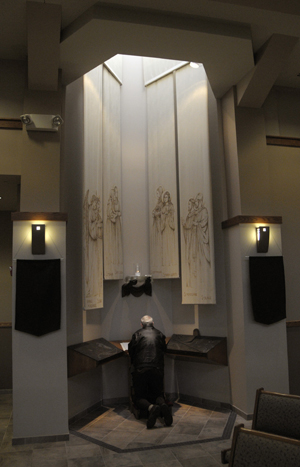
Wilted flowers of fading hues.
Rows of burning votive candles and cardboard inscribed notes they will never read.
Handmade wooden cross – the name printed with a black marker.
The setting has become so recognizable. Cultural and public outpouring of grief, an impromptu shrine for a victim who will never see it.
Almost predictably, people flock to the site of tragedy or death, murder or the home of a missing person. Seeking a sense of purpose and to shrug feelings of helplessness, the grieving build makeshift shrines for loved ones.
Forgotten or neglected, the fragments of weathered paper, wax remnants and composting flowers erode into a distant memory of what once was. The tangible becomes the intangible and grief hovers with no purpose, no place to go.
Inside a corner of St. Martin of Tours Catholic Church in Franklin, time stands still as people visit the permanent healing shrine to seek solitude, pray, meditate or savor the silence.
Designed in 2005 by Dennis Horbinski, liturgical design consultant, the shrine is a tangible way to receive healing, or offer it to others, whatever the tragedy, circumstances or illness.
Stemming from the parish’s personal tragedy 20 years ago, the shrine was designed to provide hope and healing, said Mary Worley, parishioner and construction committee member.
“This was built in honor of a young man who was mentally disabled; he was molested by a clergy member and later committed suicide,” she said. “The family did not want reimbursement, but they did want something done as a memorial in his name to offer healing to others. So when St. Martin was built after the merging of Holy Assumption and Sacred Heart of Jesus, we thought it would be a good time to create the shrine.”
The idea was presented to former Milwaukee Archbishop Timothy M. Dolan who not only embraced it, but also presented the parish with $20,000 toward the shrine.
Worley and Horbinski asked parishioners for input into the design, created entirely by local artists.
“We wanted them (parishioners) to know what we were thinking and wanted to know what they were thinking when we worked on this,” said Horbinski. “We talked about all the saints that are known for the healing and their reputation, the history of them, even rumors of healing. We ended up with 20 to consider, which was too many so we narrowed them down to a few and those were the saints incorporated into the design.”
Once the saints were chosen, Horbinski wanted to include artistic banners of four of the saints, but in slightly different poses rather than in their traditional images.
“We wanted them to be more in keeping with the atmosphere of the church,” he said. “Each saint you see was for a specific reason such as cancer, mental illness, health care, desperate issues, alcohol, blindness, etc. and paired together.”
The tapestries include St. Monica, St. Raphael the Archangel, St. Jude and St. Dymphna, and Horbinski utilized the skills of Bay View area artists, such as Heidi Minkel, to create the designs.
“I had the idea to paint these saints on cloth to give a very soft and soothing feeling,” Horbinski said. “Heidi wasn’t sure that she could do it, and I told her that I knew she could. She did it and it turned out very well.”
The next step was to ask parishioners to bring in meaningful items that offered healing, comfort or soothing memories. Some brought in canes, Bibles, poetry, rosaries, medals and even a couple of golf balls. Many of these sacramentals and remembrances were incorporated into the plaster along the sides of the tablet.
“The golf balls were included because there was a certain family from the parish whose brother-in-law was on his death bed,” said Horbinski. “He held onto these golf balls, rolled them in his hands – they soothed him and the family prayed together. We put things like this on the tablet as remembrances.”
Including a perpetual flame or light into the design stumped Horbinski until a meeting with Archbishop Dolan brought the plan together.
“The eternal light for healing came out of a meeting with then pastor, Sacred Heart Fr. Tony Russo, now retired,” he explained. “We were having a conversation with the archbishop about how to include the flame into the design and he came up with using the hands of Jesus – because Jesus is the great healer.”
Artists from Milwaukee-based Wanner Sculpture studios cast the hands that have spikes in them as Jesus endured in his crucifixion. A perpetual candle in a glass holds the flame.
Worley wishes the shrine were more utilized, but she is encouraged by the names written in the book, offering remembrances or asking for prayer.
“There are hundreds and hundreds of names in the prayer book,” she said. “And we have a good turnout when we have healing prayer services twice a year.”
Parish secretary Diane Winkowski feels a sense of peace and healing when she is near the shrine.
“It is good for anyone going through grief or just a tough time,” she said.
Worley agreed, and admitted she finds the shrine very consoling.
“In addition to the draperies with the images of the saints known for healing, we also have prayer cards, medals and then the sculpted hands of Jesus,” she said. “Just seeing his hands holding the eternal flame is very comforting. I always make it a point to attend the healing services.”
